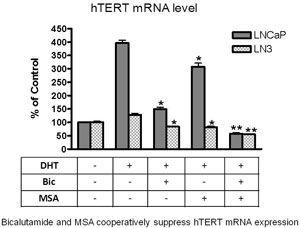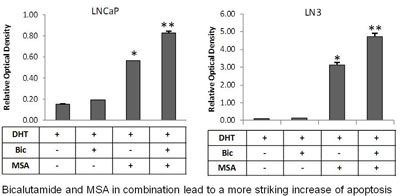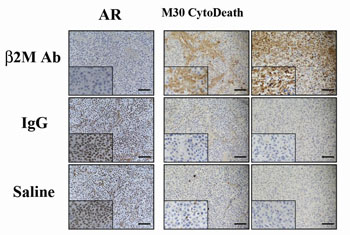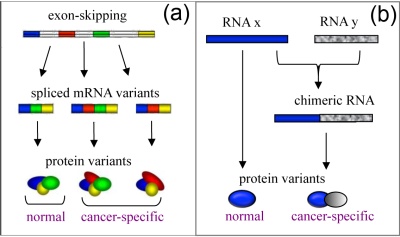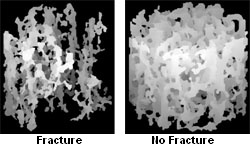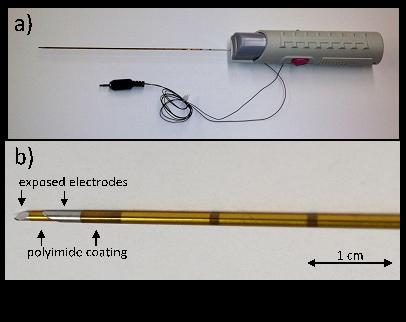


- Synergistic Effects of Natural Compounds for Prostate Cancer Prevention and Treatment
- Novel Combinations to Enhance Androgen Targeting in Prostate Cancer Treatment
- PCRP Clinical Consortium Accelerates Enzalutamide to FDA Approval
- New Approaches for Targeting the AR Pathway
- Optimizing Treatment of Advanced Prostate Cancer
- Biomarker Validation: Moving the Lab Toward Patients
- Genomic Approaches to Detect Cancer Proteins
- High Resolution MRI to Better Predict and Prevent Bone Fractures
- Better Prostate Biopsies Through Electrical Impedance Spectroscopy
Synergistic Effects of Natural Compounds for Prostate Cancer Prevention and Treatment
Posted October 23, 2012
Piwen Wang, Ph.D., University of California at Los Angeles
Natural therapeutic treatment options, or neutraceuticals, are a topic of great interest for cancer patients. Dr. Piwen Wang, a FY09 Prostate Cancer Training Award (Postdoctoral) recipient from the University of California at Los Angeles, and his mentor Dr. Susanne Henning investigated the combinatorial treatment of green tea with quercetin, a natural compound found in apples, broccoli, onions, and other dietary sources. Dr. Wang hypothesized that quercetin could enhance the anti-cancer activity of green tea by inhibiting an enzyme, catechol-O-methyltransferase (COMT), that typically methylates the active compound of green tea, epigallocatechin gallate (EGCG) to less active metabolites in the body. Expanding on previous results from cell culture studies, Dr. Wang administered brewed green tea and/or a quercetin-supplemented diet to immunodeficient (SCID) mice containing prostate xenograft tumors. As predicted, the combination treatment of green tea plus quercetin provided a significant increase in tumor growth inhibition after 6 weeks (45%) compared to quercetin alone (16%) or green tea alone (21%), and this synergistic effect correlated with increased absorption and decreased methylation of EGCG in the tumor tissues. As Dr. Wang continues in his prostate cancer research career, he plans to confirm these results in human prostate tissue samples, which if successful would further support the possibility of combined green tea and quercetin therapy as an improved option for the prevention of or adjunct treatment for prostate cancer. Finding a similar effect in human samples would be especially exciting given that a quercetin supplement is already on the market for the treatment of prostatitis, and thus relevant treatment options might become quickly available for cancer patients.
Novel Combinations to Enhance Androgen Targeting in Prostate Cancer Treatment
Posted October 23, 2012
Shuang Liu, Ph.D., Baylor College of Medicine, Houston, TX
Although androgen deprivation therapy is the mainstay treatment for advanced prostate cancer, relapse with castration-resistant prostate cancer invariably occurs. Castration-resistant prostate cancer is lethal and incurable, so developing effective strategies to enhance the efficacy of androgen deprivation therapy and circumvent resistance is an urgent task. Since prostate cancer cells require continuous androgen receptor signaling to maintain castration resistance, therapies aimed at diminishing available androgen receptor could enhance the efficacy of androgen deprivation treatment, as well as inhibit development of castration-resistant disease. Dr. Shuang Liu at the Baylor College of Medicine, recipient of a FY07 Prostate Cancer Training Award (Postdoctoral), hypothesized that combined treatment of cancer cells with methylseleninic acid, to reduce the availability of the androgen receptor, with the anti-androgen drug Casodex, which disrupts the binding of androgen to androgen receptor, would result in a more pronounced suppression of androgen receptor activity. To test this hypothesis, Dr. Liu characterized the effects of methylseleninic acid and Casodex, either alone or in combination, on the expression of the androgen receptor target hTERT and frequency of cell death. Dr. Liu was able to show that methylseleninic acid enhanced the cancer-killing efficacy of Casodex in both androgen-dependent and castration-resistant prostate cancer cells, and produced a robust decrease in the expression of PSA (prostate-specific antigen) and other factors, including hTERT and telomerase activity, which are required for cancer cell survival. As Dr. Liu observed that the cancer-killing efficacy of the two agents was mitigated by the restoration of hTERT, this also indicated a critical involvement of hTERT downregulation in mediating the combinatorial effect of the drugs, and points to new possibilities for future therapeutic approaches for specifically targeting prostate cancer.
PCRP Clinical Consortium Accelerates Enzalutamide to FDA Approval
Posted October 3, 2012
Howard I. Scher, M.D., Memorial Sloan-Kettering Cancer Center
The prostate cancer community has another good reason for increased hope this year. In 2011, ZYTIGA® was approved by the U.S. Food and Drug Administration (FDA) for treatment of metastatic, castration-resistant prostate cancer (mCRPC). And now in August 2012, less than a year later, the FDA has approved the use of enzalutamide (formerly called MDV3100 and marketed as XTANDI®) for patients with mCRPC who have failed docetaxel-based chemotherapy. Enzalutamide is a second-generation androgen receptor (AR) inhibitor that acts at multiple steps in the androgen receptor signaling pathway. Enzalutamide prevents androgen binding to the AR in prostate cancer cells, inhibits AR translocation to the nucleus, and blocks the interaction of AR with cofactors that are required for growth of prostate cancer cells. The Prostate Cancer Clinical Trials Consortium (PCCTC, www.pcctc.org), made possible through joint funding support from the Prostate Cancer Research Program (PCRP) and the Prostate Cancer Foundation (PCF), was critical to rapidly completing the phase I and II clinical trials that helped to accelerate enzalutamide to approval in record time and provide a new standard treatment for prostate cancer patients.
Enzalutamide entered the PCCTC in 2007 as a phase I and II dose-escalation clinical trial in 140 patients with progressive CRPC, some of whom had previously failed chemotherapy, led by PCCTC director Dr. Howard Scher of Memorial Sloan-Kettering Cancer Center and colleagues at participating clinical research centers. The results, published in the Lancet in 2010, demonstrated that a once-daily oral dose exhibited significant antitumor effects and, interestingly, showed that patients with castration resistant prostate cancer are not always hormone refractory.
Based on these findings, an international phase III clinical trial of enzalutamide was initiated in 1,199 men from 15 countries with castration resistant prostate cancer and progressive disease after docetaxel therapy. The study, under the direction of Dr. Scher and Dr. Johann de Bono of the Royal Marsden Hospital in London, was not expected to be completed until late 2012 but was terminated early when patients treated with enzalutamide showed at interim analysis a 37% reduction in the risk of death compared with patients receiving placebo, as described in the New England Journal of Medicine in August 2012. The efficacy of enzalutamide in the treatment group compared with the control group was also evident in response rates for PSA (54% versus 2%), soft tissue disease (29% versus 4%) and quality of life (43% versus 18%). The successful acceleration of this novel androgen receptor inhibitor to FDA approval in record time adds a powerful drug to a growing arsenal of therapeutics targeting different aspects of prostate cancer and demonstrates the PCCTC's ability to employ innovation and synergy to streamline clinical investigation for the benefit of prostate cancer patients.
"The accelerated development and approval of enzalutamide illustrates how the PCCTC's unique academic-industry co-development paradigm can bring life-prolonging drugs to patients faster. Beginning with the first-in-man trial that incorporated PCWG2 metrics developed by Consortium members to insure drugs are not discontinued prematurely, to the rapid trial activation and expansion once clinical benefit was observed in the first patients treated, our model is built on successful partnerships to achieve shared goals," said Dr. Scher. Additional clinical investigations by the PCCTC and others are ongoing to study enzalutamide in conjunction with other anticancer drugs and in patients with earlier stages of prostate cancer.The Prostate Cancer Clinical Trials Consortium, jointly supported by the DoD Prostate Cancer Research Program and the Prostate Cancer Foundation, includes thirteen leading cancer centers.
Publication:
Scher HI, Beer TM, Higano CS, Anand A, Taplin ME, Efstathiou E, Rathkopf D, Shelkey J, Yu EY, Alumkal J, Hung D, Hirmand M, Seely L, Morris MJ, Danila DC, Humm J, Larson S, Fleisher M, Sawyers CL, and Prostate Cancer Foundation/Department of Defense Prostate Cancer Clinical Trials Consortium. 2010. Antitumour activity of MDV3100 in castration-resistant prostate cancer: A phase 1-2 study. Lancet 375(9724):1437-1446.
Scher HI, Fizazi K, Saad F, Taplin ME, Sternberg CN, Miller MD, de Wit R, Mulders P, Chi KN, Shore ND, Armstrong AJ, Flaig TW, Flchon A, Mainwaring P, Fleming M, Hainsworth JD, Hirmand M, Selby B, Seely L, de Bono JS; the AFFIRM Investigators. 2012. Increased survival with enzalutamide in prostate cancer after chemotherapy. N Engl J Med. [Epub ahead of print].
New Approaches for Targeting the AR Pathway
Posted September 25, 2012
Wen-Chin Huang, Ph.D., Cedars-Sinai Medical Center
Cell signaling regulated by the protein β2-microglobulin (β2M) plays an important role in the growth and malignant progression of prostate cancer cells. Treatment with an anti-β2M antibody (β2M Ab) blocks this signaling and results in a significant decrease in the expression of the androgen receptor (AR) and the AR-regulated gene prostate-specific antigen (PSA) in prostate cancer cells. Since many hormone resistant cancers develop due to androgen-independence through changes in AR-regulated signaling, Dr. Wen-Chin Huang proposed that interrupting the β2M-AR signaling pathway might provide a new approach for preventing progress of this deadly form of prostate cancer. With support from a FY07 New Investigator Award, Dr. Huang and his team at Emory University and Cedars-Sinai Medical Center performed tests in cell culture and using animal models, and found that treatment of prostate cancer cells with β2M Ab induced cell death of cancer cells without negative effects on normal prostate cancer cells. They also showed that the β2M Ab had the same effect in androgen-independent prostate cancer cells, verifying the β2M-AR signaling was indeed down-regulated by treatment with the antibody. Treatment with the β2M Ab also decreased the expression of sterol regulatory element-binding protein-1 (SREBP-1), a key protein for regulating fat metabolism, indicating that β2M Ab may play another role in reprogramming fat metabolism and homeostasis in prostate cancer cells. Since these pathways are important for the tumor to maintain active cell growth, the ability of the β2M Ab antibody to target these additional pathways would only further stress the cancer cells, ultimately making them more susceptible to cell death. Dr. Huang's research has shown the potential effects of the β2M Ab antibody, suggesting that it could be a promising therapeutic agent with low toxicity for the treatment and prevention of lethal forms of prostate cancer.
Figure. β2M Ab decreased AR expression and induced cell death of subcutaneous C4-2 prostate tumors in mice. Immunohistochemical analysis showed down-regulation of AR expression in β2M Ab-treated subcutaneous C4-2 xenograft tumors but not in the control IgG or saline-treated C4-2 tumor-bearing mice. β2M Ab also markedly induced cell death in subcutaneous C4-2 tumors assayed by M30 CytoDeath marker staining. Bar = 100 µm.
Optimizing Treatment of Advanced Prostate Cancer
Posted September 25, 2012
Elahe Mostaghel, M.D., Ph.D., Fred Hutchinson Cancer Research Center
Testosterone suppression, which results from androgen deprivation or anti-androgen therapies, remains the most effective therapy for advanced prostate cancer, but often results in the development of castration resistant disease. Dr. Elahe Mostaghel at the Fred Hutchinson Cancer Research Center had observed that despite treatments which effectively suppress blood testosterone levels, levels within tumor metastases from men who had died of advanced prostate cancer were quite high. Levels of androgen receptor and of steroid synthesizing enzymes and transport proteins were also elevated, suggesting intratumoral androgen as a factor in resistance to anti-androgen therapies. Dr. Mostaghel received a FY09 New Investigator Award to study the biology of the prostate cancer cell as it develops resistance, and one important aspect of her project addresses the paradoxical observation that the growth of some recurrent prostate tumors is actually inhibited rather than stimulated by very high doses of testosterone. Because testosterone suppression causes many side effects, the ability to treat prostate cancer with high-dose testosterone therapy could significantly alleviate those side effects. Using a mouse xenograft model of human prostate cancer, Dr. Mostaghel is dissecting tumor characteristics associated with response to this treatment strategy to identify patients which would respond positively to high dose testosterone treatments. Dr. Mostaghel is also the recipient of FY10 and FY11 Idea Development Awards and a FY 11 Exploration-Hypothesis Development Award to fund recently initiated investigations of unique issues in castration resistance. In total, these studies will provide important insight into optimizing both current and future prostate cancer therapies.
Expression of the androgen receptor (AR), steroid producing enzymes and a steroid uptake transporter in the metastases from men with castration resistant prostate cancer. Each column represents the average staining intensity for the indicated protein in the metastases of one patient. Groups of tumors can be identified which could potentially guide treatment decisions: 1) AR positive tumors with high expression of steroid producing enzymes. These tumors would be expected to respond to abiraterone (Zytiga), which inhibits steroid synthesis. 2) AR positive tumors with low expression of steroid producing enzymes. These tumors would be expected to respond to MDV3100 (Enzalutamide), which blocks activity of the AR itself; and 3) AR negative tumors. These would not be expected to respond to drugs targeting steroid production or the AR, but would require other treatments such as chemotherapy.
Biomarker Validation: Moving the Lab Toward Patients
Posted September 18, 2012
Peter Carroll, Ph.D., University of California San Francisco
Improved biomarkers are key to helping clinicians and patients make better treatment decisions. The identification of unique molecular characteristics of prostate cancer cells, and understanding the clinical significance of those characteristics, will influence decisions about the timing and intensity of treatment, or whether treatment is even necessary at all. To date, many novel prostate cancer biomarkers have been proposed, but very few have been confirmed to contribute independent information beyond currently available clinical data, and virtually none have been subject to rigorous external validation, making them an unreliable predictor for treatment decision-making. Dr. Peter Carroll's group at the University of California San Francisco has been working for a number of years on how to improve risk stratification of prostate cancer at the time of diagnosis, and had reached a point where they believed there was no further information that could be gained from standard clinical variables such as PSA levels and tumor grade. Instead they have been seeking to understand the genetics and other determinants of prostate cancer behavior, with the goal of developing new blood and tissue tests, imaging studies, and other risk stratification tools for men diagnosed with the disease. Thus, Dr. Carroll felt the PCRP Impact Award mechanism, newly created in FY10, was the perfect vehicle for supporting advancement of this type of research project, which is in line with the Impact Award's goal making a major impact toward reducing the over-treatment of primary prostate cancer. As a recipient of one of the first Impact Awards, Dr. Carroll and his collaborators Drs. June Chan and Matthew Cooperberg have started working to identify previously described, promising biomarkers in blood, urine, and tissue, and to validate these in multi-institutional cohorts of men with clinically low-risk prostate cancer. If the molecular markers are validated, the next steps will be prospective studies in the clinic to see how this new information actually influences physician recommendations and patient choices. Eventually the molecular information will be integrated with other data about clinical tumor risk, patient age and overall health, diet and lifestyle factors, and other factors to help patients make well-informed decisions with which they can be comfortable over the long-term. Through his collaborations with the University of Washington, the other members of the Prostate Active Surveillance Study sponsored by the Canary Foundation, and industry partners, Dr. Carroll plans to further leverage his support from the PCRP to achieve rapid progress in risk stratification and treatment decision-making for men with prostate cancer.
Genomic Approaches to Detect Cancer Proteins
Posted September 18, 2012
Laising Yen, Ph.D., Baylor College of Medicine
Reliable biomarkers for prostate cancer diagnosis and prognosis are still highly sought after, and one area that has not been fully explored is that of secreted proteins, such as cytokines, growth factors, and angiogenesis factors. The levels of these factors change in the transition of healthy cells to cancerous cells, which make them attractive targets for biomarker screening. Secreted proteins can also be found in blood and urine, making them detectable by a simple blood or urine test, and thus presenting a non-invasive method for cancer screening. However, effective strategies to identify cancer-secreted proteins from normal proteins have been lacking, limiting the field's progress to date. To overcome this difficulty, Dr. Laising Yen at the Baylor College of Medicine used his FY09 Idea Development Award to develop a novel genomic method for finding these secreted cancer proteins. His lab has since compiled a long list of genes encoding secreted proteins from both normal and prostate cancer tissue, and developed bait oligonucleotides to "capture" the gene transcripts expressed from secretory genes. Understanding the sequence of the captured transcripts enabled him to investigate the key differences in secretory gene transcripts, such as alternative splicing, and to analyze the changes in expression patterns between cancerous and normal tissue. The findings from Dr. Yen's work have the potential to contribute not only to the identification of biomarkers for prostate cancer screening, but also the identification of novel targets for future drug therapies.
High Resolution MRI to Better Predict and Prevent Bone Fractures
Posted September 11, 2012
Susan Greenspan, Ph.D., University of Pittsburgh
One in 5 men will have an osteoporotic fracture after age 50 and this is increased in men with prostate cancer on androgen deprivation therapy, a common treatment for prostate cancer. Bone fractures are a critical issue in these patients, since men who experience fractures have lower survival rates than men who do not. While the best test for predicting osteoporosis is by assessing bone mineral density by dual energy x-ray absorptiometry (DXA), it has been observed that many men who experience vertebral (spine) fractures are the ones not diagnosed with osteoporosis by DXA. This is presumably due to the fact that the majority of vertebral fractures are silent and DXA is not able to measure all of factors that contribute to bone strength and fractures, such as bone microarchitecture. The current standard way to assess bone microarchitecture is with a painful and invasive bone biopsy procedure. Dr. Susan Greenspan sought to re-evaluate the current paradigm for assessing fracture risk in men by using a new virtual bone biopsy technology. With support from a FY06 PCRP Idea Development Award, Dr. Greenspan's team at the University of Pittsburgh recruited prostate cancer patients on androgen deprivation therapy who had suffered a vertebral compression fracture, and compared them to men who had not. A virtual bone biopsy test was performed using a high resolution MRI with a coil around the patient's wrist, and DXA measurements and conventional spine x-rays were also collected. The study results showed that this novel technique of virtual bone biopsy provided additional information beyond the standard DXA on the risk for fracture in men with prostate cancer on androgen deprivation therapy. Dr. Greenspan hopes to use more advanced MRI machines to provide even better visualization of the bone microstructure, and also plans to test this procedure in a weight-bearing bone such as the leg, where the microarchitecture will likely have an even greater contribution to bone strength. Developing better approaches to predict the risk of bone fracture will enable physicians to tailor preventive approaches to the patient and spare men undergoing prostate cancer therapy from the debilitating impact of this side effect.
Better Prostate Biopsies Through Electrical Impedance Spectroscopy
Posted September 11, 2012
Ryan Halter, Ph.D., Dartmouth College
The technology of electrical impedance spectroscopy (EIS) has proven to be a successful method for differentiating cancer from normal prostate tissues. EIS detects the changes in cellular structure that occur as normal prostate cells become cancerous and as the tumor continues to grow. Dr. Ryan Halter first received funding from the PCRP to study the electrical properties of prostate cancer through a FY06 PCRP Prostate Cancer Training Award while he was a postdoctoral fellow at Dartmouth College. With support from his training award, he was able to demonstrate significant electrical property differences between different Gleason grades of prostate cancer. Dr. Halter then successfully competed for a FY08 PCRP New Investigator Award, which allowed him to take a significant step in translating this laboratory finding to a clinical device. Specifically, he developed a novel sensor that integrates with standard needles for prostate cancer biopsy so that it can measure electrical properties at the needle tip at the same time as tissue cores are extracted. Such adaptation of biopsy needles with this technology would enable doctors to better identify potentially cancerous regions of the prostate for biopsy, thus providing a broader assessment of the gland as compared to typical biopsy protocols. To date, Dr. Halter and his colleagues have constructed over 50 of these devices, and recorded data from approximately 35 ex vivo prostates, verifying that they are able to distinguish between cancer and benign regions of the prostate. Dr. Halter is currently working to obtain additional funding for further development of this device, and has the goal of delivering an approved product for clinic use in as little as five years.
EIS-Bx probe design, with polyimide insulation used in the clinical phase of the program.















